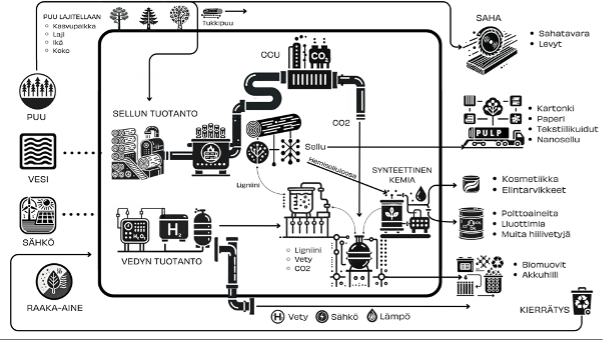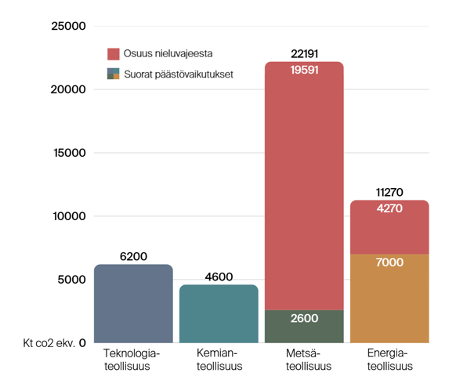Annoimme 19. marraskuuta 2025 pyynnöstä lausunnon eduskunnan valtiovarainvaliokunnalle.
Asia: HE 167/2025 vp Hallituksen esitys eduskunnalle laeiksi julkisen talouden hoitamisesta ja talouspolitiikan arviointineuvostosta sekä niihin liittyviksi laeiksi https://www.eduskunta.fi/pdf/HE+167/2025
Lausunnon pääsanomat:
- Elämme tällä hetkellä monikriisissä, jossa suomalaisen yhteiskunnan päälle vyöryy yhtä aikaa sekä lyhytkestoisia että pidempikestoisia kriisejä. Tässä ajassa talouspolitiikkaa tulee aina tehdä monikriisin haasteet tunnistaen, kestävyysmurroksen edistämisen ehdoilla ja siirtymäpolitiikkaa tukien.
- Hallituksen esityksestä eduskunnalle julkisen talouden hoitamisesta puuttuu monikriisin näkökulma. Esityksen perustana ovat EU:n uudet finanssipolitiikan säännöt, jotka myös sivuuttavat monikriisin olosuhteen. Todellisuudessa julkisten varojen käyttöä tarvitaan tällä hetkellä lisää, ei vähempää, johon EU:n taloussäännöt ja kansallinen säädöstö finanssipolitiikkaa nyt ohjaavat.
- Lakiesityksellä luodaan myötäsyklinen taantuman syventäjä ja pakotetaan Suomeen talouskuria, vaikka tosiasiassa Suomen julkinen talous on esitettyä paremmassa kunnossa, kansantalouden rahoitusasema on hyvä ja meillä on kansakuntana kykyä monenlaisiin yhteiskunnallista kestävyyttä ja taloudellista kestävyysmurrosta edistäviin hankkeisiin.
- BIOS-tutkimusyksikön mukaan finanssipolitiikan valvonnan pitää jatkossakin olla Valtiontalouden tarkastusviraston, ei Talouspolitiikan arviointineuvoston vastuulla.
***
Yleistä lakiehdotuksen julkisen talouden hoitamiselle antamista suuntaviivoista
BIOS-tutkimusyksikkö kiittää valtiovarainvaliokuntaa lausuntopyynnöstä. Kommentoimme seuraavassa hallituksen esitystä eduskunnalle julkisen talouden hoitamisesta ja talouspolitiikan arviointineuvostosta sekä niihin liittyvistä laeista. Lausuntomme alussa tarkastelemme julkisen talouden hoitamisen suuntaviivoja yleisemmin, jonka jälkeen siirrymme esityksen yksityiskohtaisempaan tarkasteluun.
Elämme tällä hetkellä monikriisissä, jossa myös suomalaisen yhteiskunnan päälle vyöryy yhtä aikaa sekä lyhytkestoisia että pidempikestoisia kriisejä tai miedompia haasteita. Näihin vastaaminen edellyttää strategista otetta ja aktiivista tulevaisuuden rakentamista kaikilta yhteiskuntamme toimijoilta. Kyseessä on mittava ja moniulotteinen kollektiivinen ponnistus, jossa eri instituutioiden, organisaatioiden, yksittäisten toimijoiden ja toiminnan on pelattava johdonmukaisesti yhteen. Tämä tarkoittaa käytännössä sitä, että yhteiskuntamme voimavarat on suunnattava näitä kriisejä kohti ja kaikkien sen osa-alueiden on parhaalla mahdollisella tavalla oltava mukana yhteisessä kriisinhallinnassamme.
Talouspolitiikka, finanssipolitiikka ja julkisen talouden hoitaminen ei ole tästä projektista irrallinen saareke. Päinvastoin se on tarvitsemamme siirtymäpolitiikan ydinaluetta. Siirtymäpolitiikalla viitataan sellaiseen yhteiskuntapolitiikkaan, joka laaja-alaisesti ja määrätietoisesti pyrkii rakentamaan yhteiskunnasta ekologisesti ja sosiaalisesti kestävän – edistämään eri päätöksin, toimenpitein ja institutionaalisin muutoksin kestävyysmurrosta suomalaisessa yhteiskunnassa. Talouspolitiikalla on siirtymäpolitiikassa keskeinen rooli siksi, että sen kautta pystytään ohjaamaan niin halutessa tehokkaasti ja tarkastikin yhteiskunnan resursseja kestävyysmurroksen edistämisen vaatimiin suuntiin. Ilmeistä siis on, että tässä ajassa talouspolitiikkaa tulisi aina tehdä monikriisin haasteet tunnistaen, kestävyysmurroksen edistämisen ehdoilla ja siirtymäpolitiikkaa tukien.
Hallituksen esityksestä eduskunnalle julkisen talouden hoitamisesta tällainen näkökulma puuttuu tyystin. Esityksen perustana ovat EU:n uudet finanssipolitiikan säännöt, jonka päälle rakennetaan oma kansallinen mekanismi finanssipolitiikan virittämiseksi ja julkisen talouden hoitamiseksi. EU:n finanssipoliittisten sääntöjen ainoa motivaatio on EU-valtioiden velkaantumisen rajoittaminen (velkasuhteen alentaminen) sekä julkisten talouksien tasapainottaminen (alijäämien leikkaaminen). Peruslähtökohta on täysin sokea aikamme tärkeimmille yhteiskunnallisille haasteille, ilmastonmuutokselle, luontokadolle, yhteiskuntarauhan horjumiselle ja talouksien infrastruktuurien murenemiselle. Ajattelun perustana tuntuu olevan, että julkinen talous ei ole millään tavalla yhteydessä ympäröivään yhteiskuntaan, sitä voidaan käsitellä yhteiskuntien kehitykselle eksogeenisena eikä sen kautta voida mitenkään vaikuttaa yhteiskuntiemme suuntaan – hyvässä tai pahassa. Tällainen lähtökohta on oikeastaan mieletön.
On Suomen yhteiskunnan ja kestävyysmurroksen edellytysten kannalta hyvin ongelmallista, että EU:ssa on päädytty tällaiseen talouspolitiikan ja julkisten talouksien hoitamisen kehikkoon. Jotta siirtymäpolitiikka voisi olla tehokasta ja toimivaa, koko kehikko pitäisi oikeastaan kiistää ja sitä pitäisi pyrkiä aktiivisesti muuttamaan. Todellisuudessa julkisten varojen käyttöä tarvitaan tällä hetkellä lisää, ei vähempää, johon EU:n taloussäännöt ja esityksessä vielä niitäkin tiukempi kansallinen säädöstö finanssipolitiikkaa ohjaavat. Ohjaus- ja päätöksentekokyvyn rajoittaminen monikriisissä on erittäin ongelmallista, sillä se voi pahimmillaan estää täysin välttämättömien investointihankkeiden toteutumisen ja siten padota kestävyysmurrosta pahimmalla mahdollisella tavalla.
EU-sääntöjä luodessa ja kansallista lainsäädäntöä kirjoittaessa niiden vaikutuksia eurooppalaisten valtioiden kapasiteettiin ohjata siirtymäpolitiikkaa ei ole kiinnitetty lainkaan huomiota tai ainakaan sääntöjen ja lakien perusteluista tällainen pohdinta ei käy selvästi ilmi. Tähän lienee johtanut jonkinlainen maailmankuvallinen sekaannus, joka ohjaa sääntöjen kirjoittajat ajattelemaan yhteiskuntien kehitystä lineaarisena, historiallisia trendejä seuraavana, luonnollisena urana, johon eivät kriisit, politiikat, ihmisten valinnat, yhteisölliset dynamiikat tai luonnon antamat reunaehdot voi oleellisesti vaikuttaa. Toisin sanoen perusongelma talouspolitiikan säännöissä ja myös esitetyssä lainsäädännössä on jo todellisuuden olemuksen tulkinnassa sekä oletuksissa siitä, mitä voimme tästä todellisuudesta tietää.
Laki julkisen talouden hoitamisesta
Hallituksen esitys eduskunnalle laeiksi julkisen talouden hoitamisesta ottaa lähtökohdakseen EU:n taloussääntöjen tarkan noudattamisen. Perusteluna finanssipoliittisten lakien uudistamiselle Suomessa ovat nimenomaan EU:n uudistetut taloussäännöt, joiden kansallisen toimeenpanon nähdään vaativan lakien päivittämistä. Tavoitteena uusissa laeissa on, että ne ohjaavat talouspolitiikkaa minimissään EU:n sääntöjen asettamien raamien sisään. Edelleen pyrkimyksenä kuitenkin on, että kansallisilla lisäyksillä luodaan turvamarginaalia, eli käytännössä kansallisesta ohjauksesta pyritään tekemään finanssipolitiikan näkökulmasta vieläkin kiristävämpää kuin mihin EU:n säännöt Suomen valtiota velvoittaisivat.
Laki tulee voimaan käytännössä vasta 2030-luvun alussa, mutta juuri solmitulla parlamentaarisella säännöllä EU-sääntöjen tiukat velvoitteet on päätetty ottaa finanssipolitiikan ohjauksen ohjenuoraksi jo seuraavan vaalikauden alusta lähtien. VM:n laskelmien perusteella sopimuksesta ja laista seuraa tuleville vuosille jatkuva julkisen talouden sopeuttaminen, jonka mittaluokka liikkuu lopulta toteutuvasta talouskasvusta riippuen jossain 6 mrd. ja 20 mrd. euron välimaastossa nettomääräisesti. Käytännössä Suomessa ollaan siirtymässä ainakin vuosikymmenen mittaiseen talouskuriin, joka voidaan välttää ainoastaan hyvällä julkisen talouden sopeutuksesta riippumattomalla yksityisen sektorin talouskasvulla.
Valitettavasti yleensä ja erityisesti monikriisissä, jossa taloudellinen epävarmuus on suurta, yhteiskuntapolitiikalta odotetaan tavallista enemmän suunnannäyttöä ja julkista taloutta on syytä käyttää suotuisan taloudellisen kehityksen tukemiseksi (investoinnit ja julkinen kulutus kokonaiskysynnän perustana), edellinen taloudellinen olosuhde on erittäin epätodennäköinen. Paljon todennäköisempää on, että julkisen talouden sopeutus aiheuttaa Suomen taloutta kurjistavan kierteen, jossa kokonaiskysyntä tasaisesti alenee, epävarmuus lisääntyy ja talouskasvu loppuu kokonaan niin kauan kuin sääntöjen mukainen sopeutus jatkuu. Tällaiset pohdinnat puuttuvat kokonaan lakiesityksessä eikä tällaista kehitysuraa näytetä pitävän lainkaan mahdollisena.
Vaikka laissa implikoidaan jonkinlaista joustavuutta ja harkinnanvaraa tilanteessa, jossa edellä kuvatut dynamiikat toteutuvat, on sen tahtotilana nimenomaan toimia julkista taloutta kiristävänä mekanismina taantumissa. Toisin sanoen lakiesityksellä pyritään tietoisesti luomaan myötäsyklinen taantuman syventäjä. Sen sijaan siinä tapauksessa, että yksityinen sektori tuo tulevina vuosina Suomen talouteen merkittävän kasvupyrähdyksen, julkisen velan BKT-suhde alenee automaattisesti, jolloin sopeutusta ei tarvita välttämättä lainkaan. Näin esitetty malli julkisen talouden hoitamisesta on selkeästi epäsymmetrinen.
Kun koko lainsäädännön kirjoittaminen on aloitettu EU:n sääntöjen asettamalta pohjalta, missään vaiheessa lainsäädännön perusteluja ei pohdita sitä, mitkä ovat Suomen kansantalouden ja julkisen talouden todelliset rahoitusrajoitteet. Tätäkin voidaan pitää ainakin kansallisen autonomian ja suvereniteetin vaalimisen näkökulmasta ongelmallisena. Todellisuudessa julkisen talouden rahoituskestävyyden määrittää viime kädessä kansantalouden ulkoinen tasapaino siten, että pitkään ulkomaille jatkunut velkaantuminen tuottaa lopulta rahoituskriisin – joko valuuttapaon ja valuuttakurssin heikkenemisen, kansantalouden toimijoiden rahoituksen hinnan nousun tai molempien seurauksena. Suomen kansantalous on viime vuosina saavuttanut pysyvältä näyttävän ulkoisen tasapainon, jota voidaan edelleen vahvistaa muun muassa energiaomavaraisuutta lisäämällä, kansantalouden sisäisiä kiertoja vahvistamalla ja vientiä edistävällä monipuolisella politiikalla. Nykyinen tilanne antaa Suomelle liikkumavaraa entisestään vahvistaa rahoitusasemaansa näillä talouden alueilla. Lisäksi on huomioitava, että Suomen julkisyhteisöillä on merkittävästi likvidejä varoja, joiden myötä sen rahoitusasema on huomattavasti parempi, kuin mitä EU:n sääntöjen keskiössä oleva bruttovelkasuhde osoittaa. Nämä tekijät on jätetty kokonaan sivuun suomalaisessa keskustelussa julkisten talouden hoitamisesta, mitä voidaan pitää jokseenkin omituisena.
Kaiken kaikkiaan voidaan todeta, että Suomen julkinen talous on esitettyä paremmassa kunnossa, kansantalouden rahoitusasema on hyvä ja meillä on kansakuntana kykyä monenlaisiin yhteiskunnallista kestävyyttä ja taloudellista kestävyysmurrosta edistäviin hankkeisiin. Nyt esitetyllä finanssipoliittisella lailla tämän liikkumavaran käyttöä pyritään joko tietoisesti tai tiedostamatta patoaman merkittävästi. Tällä on väistämättä negatiivinen vaikutus Suomen valtion kykyyn ohjata siirtymäpolitiikkaa ja edistää yhteiskunnalle välttämätöntä kestävyysmurrosta.
Laki talouspolitiikan arviointineuvostosta
Hallituksen esityksessä ollaan lisäksi muuttamassa finanssipolitiikan valvonnan rakenteita Suomessa. Käytännössä tämä tarkoittaa sitä, että eduskunnan alaiselta Valtiontalouden tarkastusvirastolta ollaan siirtämässä päävalvontavastuu Talouspolitiikan arviointineuvostolle, jonka jatkossa esitetään koostuvan yliopistoilla toimivista taloustieteilijöistä. Muutos herättää paljonkin kysymyksiä ja tärkeimpänä sen, onko jatkossa Suomessa puolueetonta ja neutraalia talouspolitiikan valvontaa lainkaan.
Esityksessä Talouspolitiikan arviointineuvoston nimittää valtioneuvosto. Sillä on siis mahdollisuus jatkossa valita ne henkilöt, jotka arvioivat hallituksen toteuttamaa talouspolitiikkaa. Vaikka esittelyvastuu on lakiesityksessä osoitettu valtiovarainministeriölle ja sen toivotaan vakaasti noudattavan yliopistojen tekemiä ehdotuksia, mitään todellista estettä ei rakennetta sen tielle, että hallitus nimittäisi arviointineuvostoon haluamansa jäsenet poliittisin perustein.
Tämä saattaa olla demokratian ja talouspoliittisten sääntöjen noudattamisen näkökulmasta hyväkin asia. Koska hallitukselle myötämieliset arvioijat tuskin esittävät merkittävästi eriäviä tulkintoja talouspolitiikasta, ja koska lainsäädännössä kovinkin velvoitus hallitukselle ja eduskunnalle on arviointineuvoston huomioihin vastaaminen (selittäminen), lopulta kansallisesta säännöstöstä ei lopulta seuraa minkäänlaisia rajoitteita hallituksen ajamalle ja eduskunnan enemmistön päättämälle talouspolitiikalle.
Jos kuitenkin talouspolitiikan arviointineuvoston ja istuvan hallituksen välille syntyy syvä erimielisyys talouspolitiikasta, voi esimerkiksi edellisen hallituksen nimittämä arviointineuvosto oleellisesti määrittää sitä talouspoliittista ympäristöä, jossa uusi hallitus toimii tiukoilla kannanotoillaan ja vastalauseillaan harjoitetusta politiikasta. Näin lainsäädännöllä ja arviointineuvostolla onkin ehkä lopulta mittavasti niin sanottua pehmeää ja julkisuuden kautta tapahtuvaa poliittista valtaa, joka tietyissä tilanteissa saattaa haastaa radikaalistikin istuvan hallituksen tavoitteet. Tämä puolestaan olisi vaalidemokratian toteutumisen kannalta hyvinkin ongelmallista.
BIOS-tutkimusyksikön selkeä kanta finanssipolitiikan valvontaan onkin se, että se pitää jatkossakin olla Valtiontalouden tarkastusviraston vastuulla.



